WU Gengsheng, LIANG Zhaohui, YANG Xiaoqin
Abstract: Continuing education plays a more and more significant role in today’s society. As the leading university inChina,TsinghuaUniversitybegan its continuing education in 1997.Enterprisetraining, especially Small and Medium Enterprises training, is now playing an important role in remote education ofSchoolofContinuing Education,TsinghuaUniversity. To fulfill the training needs of SMEs, SVL and SSL mode e-learning platform is built up. From 2002,TsinghuaUniversityhas initiated its educational poverty alleviation project and has gained good social effects.
Keywords: SMEs training, SVL mode, SSL mode, Educational Poverty Alleviation
Authors: WU Gengsheng, Prof., Vice Dean,SchoolofContinuing Education,TsinghuaUniversity
LIANG Zhaohui, Deputy Director,RemoteEducationTechnologyCenter,SchoolofContinuing Education,TsinghuaUniversity
YANG Xiaoqin, Vice Prof. School of Continuing Education,TsinghuaUniversity
Introduction
As one of the earliest schools that took up continuing education,TsinghuaUniversitybuilt up its e-learning system in 1997. In the first years, the way of continuing education was copied just like it was in school education with the whole teaching system, 3-5-year of schooling and diploma as the target. With no learning process being monitored, examination was the only way to checkout the study effect of students. This deviates from the original intention of continuing education. So in 2004,TsinghuaUniversitydecided to stop recruiting new students for diploma-oriented education. The new age of Tsinghua’s continuing education began.
Through the analysis of the domestic training market situation and the training needs of the community,SchoolofContinuing Educationchose the short-term training for the community and enterprises as a new breakthrough. Through years of hard work, relying on the quality assurance of teaching resources, SCE made tremendous social and economic benefits.Enterprisetraining is becoming more and more important in SCE’s distance learning. As a repaying to the society, from 2002, educational poverty alleviation project started and the corresponding platform is built up.
Enterprise-oriented training
Because of the characteristics of distance learning, SCE must choose a training market to meet the following two conditions: one is that the market is big enough to achieve economies of scale; two is that the market need training very much and can afford the training fee. Through the analysis of the training market, SCE made a choice of SMEs training as its major business of distance learning.
According to statistics, till the end of 2006, the number of SMEs is about 4 million and the individual industrial and commercial households are over 40 million. They occupy about 99% of the number of enterprises ofChina. SMEs create about 58% of the ultimate value of the products and services of GDP and provide about 75 percent of urban employment opportunities. In 2004 nearly 50% of the college graduates obtained employment in SMEs. SMEs are playing a more and more important role inChina's economic development.
As we all know, innovative capabilities and human resources are the two main factors deciding the success or failure of SMEs. Not like large enterprises which can invest a lot of money in human resources and training, SMEs of China are lack of investment awareness and ability on human resources and training. For most mini-enterprises, it is expensive to build up their own internal training platform.
In order to fulfill the limited training demand of a single SME and the unlimited demand of all the SMEs. The training for SMEs of SCE is divided into two modes according to different condition of the SMEs. One is the Server-Virtual server-Learner (SVL) mode; the other is Server-Server-Learner (SSL) mode.
SVL MODE
Server-Virtual server-Learner Mode is mainly for those mini-enterprises with no ability to build up their own training system because of financial or technical constraints. Some of these mini-enterprises, actually, even have no human resource office. At the same time, rapid developments change the management and human resource structure of the enterprises more often. There are two special parts in SVL mode. One is the training plan management part and the other is the human resources evaluation part.
SVL mode is close to the traditional e-learning mode (see Figure.1). In the traditional mode, a center server or server cluster is built up to serve all learners. The basic functional modules include registration, courses selection and studying, calendar, study recording or history, homework and test. SVL mode has all these functions. A little different to traditional mode, SVL mode has a Virtual-Server layer between the center servers and the learners. As its name shows, the Virtual-Server layer is not a hardware layer, but a virtual software layer and serves the administrator or the training manager of the mini-enterprises. SVL is a B2B mode. The mini-enterprises pay the training fee of their staff. So the administrators or the training managers control the study of their staff according to the need of enterprise development.
SVL provides enterprises a simple human resources evaluation system to help them find out the most needed knowledge for their staff. When the system gets the evaluation results, it can suggest relevant courses for them. The administrator or the training manager chooses courses and arranges the training plan for different staff members.
SVL mode provides different learning interfaces for different SMEs according to their customs. It is like that every SME has its own training platform. They can put their own training materials on their “own” platform without buying expensive hardware and software.
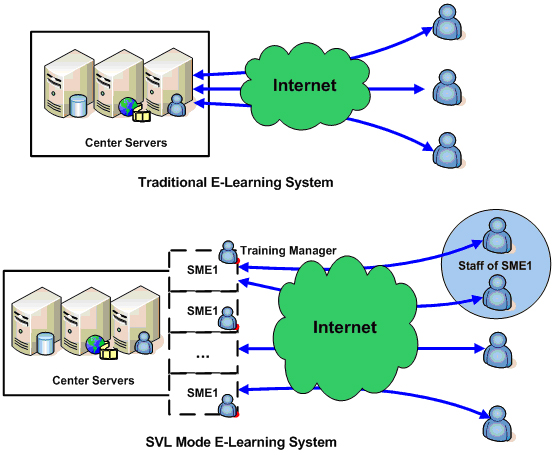
Figure.1 The technological diagram of SVL mode
The biggest problem of SVL mode is bandwidth consumption and access traffic. In essence SVL mode is still a traditional e-learning platform with center servers bearing the entire access burden. The cost of bandwidth is the biggest payout. How to deal with unexpected traffic is still a big problem. The more SMEs SVL serves, the greater the pressure is on the system. Maybe in the future, if there are enough learners on this platform to learn the same courseware at the same time, P2P network technology will be apply on the center servers to save bandwidth.
SSL MODE
In recent years, with the development of enterprise information, many companies set up their own e-learning platform. For those enterprises, SSL (Server-Server-Learner) mode is designed. The core of SSL mode is to use the LAN of enterprises to perform the real training and use the Internet to connect the enterprise e-learning servers to the service center of SCE into a distributed training platform.
SSL mode training platform is a web-based (Internet or LAN) online training management platform to help enterprises build training systems, develop training plans, organize training executions, fulfill training evaluations or examinations. The platform integrates corporate training, human resource development and knowledge management into one system. In SSL mode, the e-learning system is divided into three parts: online learning, learning management and courses delivery system.
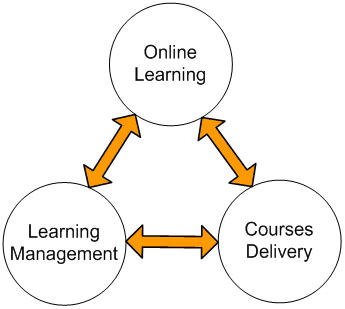
Figure.2 Three parts of SSL mode
The online learning platform is staff-oriented.Enterprisestaff members log into the online learning platform to learn courses according to the training plan made by the Human Resources Department for them in the required time. Through the enterprise internal and external experts’ online messages, learners can access to advice and FAQ, and exchange learning experiences. Along with the courses there will be tests, homework, examinations to check the effect of learning.
Learning management is for the enterprise Human Resources Department, who decides what to learn as well as how to evaluate the studies.Enterprisehuman resources management departments use the platform, according to business development objectives and staff competence and quality assessment, to form the staff’s career development planning. This helps to decide curriculums and training plan of staffs. Training programs are made for different levels of staff. The training process is recorded and training examination results will be submitted to the Personnel Files. The old training files can be used for analysis and develop training programs of the next phase. Training files also become references of exchange or promotion.
The courses delivery system is the bridge between SMEs’ servers to center servers of SCE. Enterprise Human Resources Departments, based on investigation and analysis of training needs, select required courses from Center Server of SCE into the enterprise learning platform. On the other hand, they can use this platform to develop courses of their own such as the enterprise management rules and processes, product knowledge, technical documentation, leadership speeches and typical cases, and upload to the enterprise learning platform.
With the servers installed in SMEs, SSL mode forms a mesh network of course sharing platform (see Figure.3). The center servers of SCE act as a supermarket of courseware. SMEs’ users can search and preview online the training resources on center servers, order the courses they need and promote their training needs. After the confirmation of the Enterprise Human Resources Departments, the courses can be transferred into the local enterprise server. It is easy to apply P2P technology on this mesh network which can help decrease the bandwidth consumption.
The biggest problem of SSL mode is courseware copyright protection because the course ordered by enterprises will be stored and used on the LAN of SMEs. So, in SSL mode, all the course learning must pass the certification on center servers. Thus the center servers can control the copyright of all courses. On the learner’s side, activex objects or plugins embedded into the internet explorer are used to ease the certification. All the platforms are based on Java technology and can easily apply on different systems.
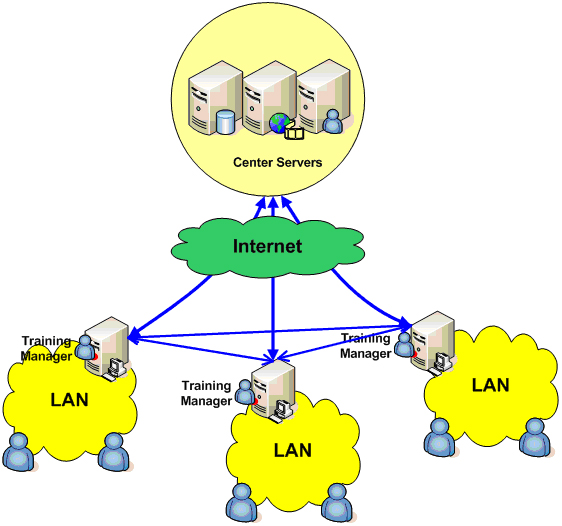
Figure.3 Technical Diagram of SSL mode
Educational poverty alleviation
Even though the Chinese economy has been developed rapidly in recent years, the economic gap becomes wider between the east and west part ofChina. How to help those in the west is a big problem to allChina. China’s poverty alleviation has experienced several processes: food → clothes → funds → enterprise → high quality human resources. There is a famous saying: helping the poor, first helping their intelligence. As one of the most famous universities inChina, Tsinghua act well on its social responsibilities. In 2002, Education Alleviate Poverty Project: Dispreading Knowledge and Reducing Poverty through ICT were initiated in return for the society and in order to help the poverty-stricken areas ofChina. SCE is chosen to develop this project. Its goal is to provide people in underdeveloped areas with the opportunity to utilize high-quality educational resources through the support of modern technology.
Till now about 180 state-level poverty-stricken counties (i.e. those with a standard of living below the national poverty line, inChinait means the income is below 100 U.S. dollars per person every year) have been built up mainly inWestern China. SCE establishes distance learning centers free of charge, and provides free critical educational resources to officials, primary- and middle-school teachers, students, and farmers.
As we all know, the traffic, information and communication conditions are very poor in those poor areas. “Digital Gap” increases poverty gap between west and east, urban and rural areas inChina. In such a large country asChina, satellite technology is feasible for those remote areas. At the same time, interactive systems are built up to exchange information between teachers and students. In some area, SCE is testing to transfer courses via CATV to family.
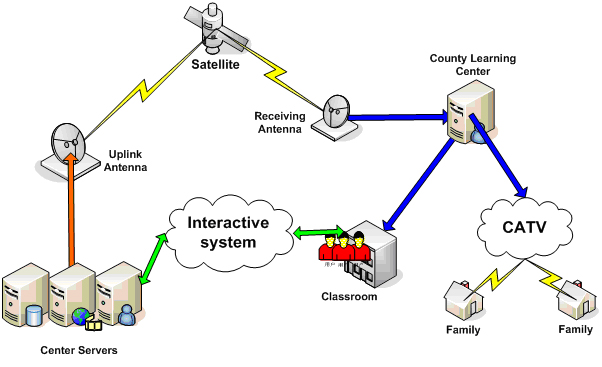
Figure.4 Technical Diagram of Educational Poverty Alleviation
The goal of Educational Poverty Alleviation Project is to use ICT to establish three levels of learning centers in counties and villages: county learning resource centers, village and town learning centers, and rural level multimedia display spots. Here is the diagram of it.
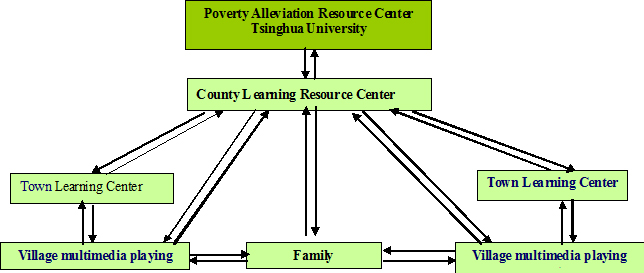
Figure.5 Three Levels of Educational Poverty Alleviation
There is a great plan for the Educational Poverty Alleviation Project. By 2010, the distance learning centers will be established in the other 500 national poverty-stricken counties. Online and On-satellite courses will cover 1,000 high schools in those counties. The project will benefit 40 million people in poverty-stricken areas.
Conclusion
SCE designed SVL and SSL mode platforms to fulfill the training needs of SMEs of China. But only having training systems is not enough for them. The market is changing, and SMEs are changing, so the training mode must change accordingly. On the other hand, training needs of different SMEs are various. In the future, SCE will try to do more in the search and application of SME Training Consulting and introduce training consulting systems to SMEs. Online expert systems will be built up to meet the demand of training consulting.
The quick development of new technology may bring progress in distance education. The platform may be more intelligent to help the training management of SMEs. Bandwidth may be cheap enough or wide enough to take high quality training courses.
References
[1]Wu Gengsheng, Zhang Ying, Dou Jian. Distance Learning inTsinghuaUniversity: Proceedings of the International Conference on Distance Education, Distance Learning and 21th Centuru Education Development. April 12-15, (1999)
[It was published by The 4th APRU Distance Learning & Internet Conference 2007]
